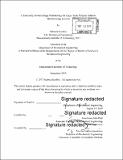A thermally-driven design methodology for large-scale polymer additive manufacturing systems
Author(s)
Kurfess, Rebecca(Rebecca Ann)
Download1138947006-MIT.pdf (14.12Mb)
Other Contributors
Massachusetts Institute of Technology. Department of Mechanical Engineering.
Advisor
Anastasios John Hart.
Terms of use
Metadata
Show full item recordAbstract
The extrusion additive manufacturing (AM) process involves selectively dispensing melted material out of a nozzle onto a build platform to form a layer, moving the build platform down, and extruding the next layer. The strength of polymer welds between layers of extrusion AM parts is lower than the strength of the bulk material itself. These welds are formed when a new layer heats the previous layer enough to initiate the diffusion of polymer macromolecules between layers [1]. To obtain acceptable adhesion between two layers, the temperature of the interface between layers must remain high enough for a long enough period of time to drive the diffusion process. Inter-layer welding is of special concern in large-scale extrusion processes, as the large thermal gradients induce residual stresses that can overcome weak inter-layer welds, causing warping and cracking [2]. To gain insight into and mitigate inter-layer inconsistency, a thermal model relating flow rate and layer temperature based on part and bead geometry, material properties, and print conditions was derived in this thesis. This model of the temperature of a single layer, assumed to be isothermal, was used to develop a model of the interface temperature to determine the impact of heat transfer between a cooled layer and the subsequently extruded layer. An expression for normalized weld time was derived to relate times at different interface temperatures to time at a reference temperature. These models are used to determine the maximum cooling time allowed for a given layer geometry and set of print parameters before the layer reaches a temperature at which unacceptably weak inter-layer welds will form when the next layer is extruded. A relationship between required minimum interface temperature, flow rate, and print head velocity was developed, and the relationship between BAAM system flow rate and extruder screw diameter was derived to enable extruder screw diameter selection appropriate for the flow rate requirement.
Description
Thesis: S.M., Massachusetts Institute of Technology, Department of Mechanical Engineering, September, 2019 Cataloged from PDF version of thesis. Includes bibliographical references (pages 87-90).
Date issued
2019Department
Massachusetts Institute of Technology. Department of Mechanical EngineeringPublisher
Massachusetts Institute of Technology
Keywords
Mechanical Engineering.